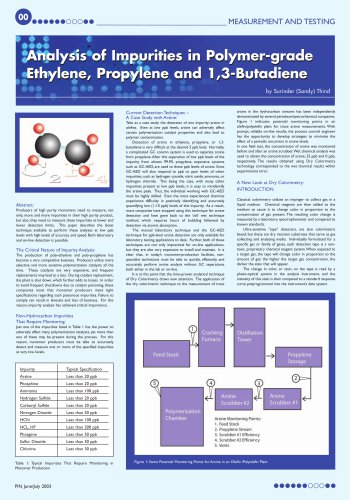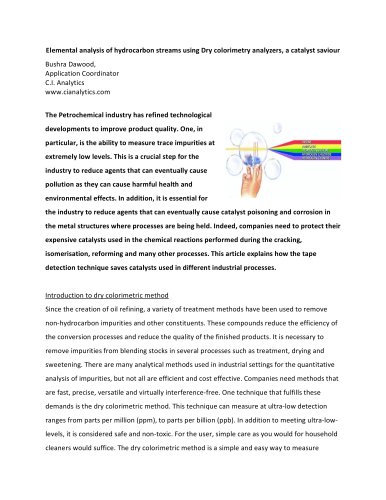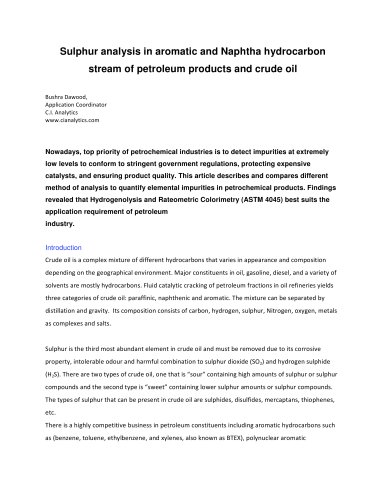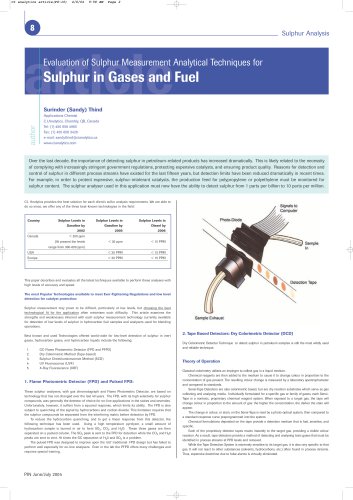"
00
Analytical Instrumentation
article
The On-Line Detection of Oxides of Nitrogen in Light Hydrocarbon Streams
author
by Modified Chemiluminescence Detection
and/or by Dry Colorimetric Detection
Surinder (Sandy) Thind
Applications Chemist
C. I. Analytics
www.cianalytics.com
Abstract:
Producers of high purity monomers (ethylene) have identified the
need to measure the presence of Oxides of Nitrogen (NOX) at very
low PPB levels, and take steps to avoid potentially hazardous
conditions, in the Cold Box.
NOX (NO and NO2) in the olefins processing train is a safety
concern. There is a possibility of accumulation of unstable liquid or
solid nitrogen oxide (N2O3) and nitrogen oxide-organic solids in
the cold processing equipment.
In the Cold Box of ethylene production plant at temperature,
130 C to 170 C, oxides of nitrogen may combine with dienes (gums)
and form potentially explosive nitrated resins.
During, shut down, at the time the olefins recovery train is
allowed to warm up, any cracked gas flow passing through sections
where N2O3 has deposited, will lead to the formation of extremely
hazardous conditions. This is due to the reaction of NO2 and N2O4
with heavier olefinic materials. The NO2 can react with olefinic
materials to form “gums”. These ‘gums’ formed are explosive at
cryogenic temperatures. NOX deposits represent the presence of
a powerful oxidizer in a system filled with flammable materials.
Even though, in theory, Nitric Oxide (‘NO’) is the only NOx
species that reaches the cryogenic ethylene recovery unit, it is also
required to measure other species that belong to NOX group.
If NOX levels are below five parts per billion in the cracked gas,
then accumulations would not be expected to occur. However, if
the concentration is over 30 ppb, accumulations in one form or
another are assured.
The analytical challenge of NOx in Light
Hydrocarbons Analysis:
The measurement of 1 ppb-50 ppb levels of NO in complex olefins
matrixes is a major analytical challenge. The detection is required
at 1 PPB level. This is difficult due to the presence of major
interference of the matrix and trace level contaminants at PPM
levels.
Many analytical techniques fail in this application, including
GC-Chemiluminescence and GC-PID due to lack of the required
sensitivity or specificity.
C.I. Analytics has solved this analytical problem using two
different detectors. One is Dry Colorimetery Detector and the other
is the modified GC-Chemiluminescence.
In the past, several efforts have been made to detect NO using
Gas Chromatography followed by detection using either a Photo
ionization detector or traditional chemiluminescence detector.
Both these detectors require accurate gas chromatography work
and slight variation in retention time will result in false results.
The PID can detect down to 80 PPB. The GC-Chemiluminescence (traditional detector) is not truly applicable to online work, while experienced chemists have made detections at 50
PPB level. This does not meet the analytical requirements of
measuring NOX at levels much below 50 PPB.
The new modified chemiluminescence detector by C.I.
Analytics and another field proven technique, Dry Colorimetery
method to detect NO provides a successful technical solution to
this analytical problem.
Current Detection Techniques
A Case Study with GC-PID or GCChemiluminescence:
Take as a case study the detection of one impurity:
Nitric Oxide in Ethylene.
Detection of nitric oxide in ethylene, propylene, or 1, 3 butadiene is
very difficult at the desired 1 ppb level. Normally, a complicated GC
column system is used to separate nitric oxide from propylene.
After this separation of low ppb levels of the impurity from almost
99.9% ethylene and other ppb or ppm levels of other impurities,
such as hydrogen cyanide, nitric oxide, ammonia, or hydrogen
chloride. This being the case, with many other impurities present
at low ppb levels, it is easy to misidentify the NO peak. Thus, the
individual working with GC-PID must be highly skilled. Even the
most experienced chemists experience difficulty in positively
identifying and accurately quantifying low (1-10 ppb) levels of this
impurity. As a result, most companies have stopped using this
technique for NO detection.
The laboratory technique, the GC-Chemiluminescence or GCPID technique for ppb-level NO detection is only available for
laboratory testing applications to date. Further, both of these
techniques are not only impractical for on-line applications, but
they are also very expensive to install and maintain. It is clear that,
in today’s monomer-production facilities, non-specialist
technicians must be able to quickly, efficiently, and accurately
perform NO analysis without GC separations both either in the lab
or on-line.
Using Modified GC-Chemiluminescence.
The traditional Chemiluminescence detector, for the detection of 1
PPB levels of NO requires reaction of NO with Ozone at reduced
pressure. That means there is a need for the use of a vacuum
pump. This pump will create reduced pressure in the reaction cell
of the detector. The detector response will change as the vacuum
conditions change. Plus, vacuum at the end of GC column leads to
retention time problems. If retention time is shifted, then false
results will be reported. Not to mention total failure if ethylene
reaches the detector, as ethylene will give a big response (false
peak).
The GC-Chemiluminescence detector responds to PPB levels
of ethylene. So, the choice of the GC-columns is extremely
important. Two conditions must be observed. First, the analytical
column must separate NO from ethylene. Second, the complete
system must be inert. The columns, valve, loop and connective
tubing must not adsorb NO at low levels.
All these factors have made on-line detection of NO very
difficult, even though, in some labs, good results at 50 PPB level
have been achieved.
C.I. Analytics has solved this problem. The need for use of
vacuum pump has been eliminated. The analytical system is made
inert; the photomultiplier tube has been replaced by another photo
sensitive device. The problems associated with interferences have
been reduced. The ethylene at PPM levels will not interfere. The
GC Columns are packed 1/8 inch and the detector is sensitive
down to 1 PPB level of NO.
Figure 1: CI Analytics On-Line NO Analyzer
C.I. Analytics: GC-Chemi for 20 PPB NO detection at customer
location since the year 2000.
process control engineer has the opportunity to develop strategies
to minimize the formation of potentially explosive nitrate resins in
the cold box. The results obtained using Dry Colorimetery
technology corresponded to the laboratory results, using GCchemiluminescence, within experimental error.
C.I. Analytics has developed a special formula that is deposited
on the filter tape. This tape will respond only to NOx.
A New Look at Dry Colorimetery:
Introduction
Classical Colorimetery utilizes an impinger to collect gas in a liquid
medium. Chemical reagents are then added to the medium to
cause it to change color in proportion to the concentration of gas
present. The resulting color change is measured by a laboratory
spectrophometer and compared to known standards.
Ultra-sensitive “tape” detectors are also colorimetric based, but
these are dry reaction substrates that serve as gas collecting and
analyzing media. Individually formulated for a specific gas or family
of gases, each detection tape is a non-toxic, proprietary chemical
reagent system. When exposed to a target gas, the tape will
change color in proportion to the amount of gas: the higher the
target gas concentration, the darker the stain that will appear.
The change in color, or stain, on the tape is read by a photooptical system in the analysis instrument, and the intensity of this
stain is then compared to a standard response curve preprogrammed into the instrument’s data system.
Analytical Technique
Using Dry Colorimetery Detection for
1 PPB level NOx.
The GC-Chemiluminescence detection requires more attention
than the on-line service teams has the time to devote. Is there
another technique that will give accurate results without the need
for special care? In addition, it is desired for complete safety and
prevention of explosive resins, that Total NOx be measured and
reported instead of assuming that only NO will reach the cold box.
It is at this point that the time-proven analytical technique of
Dry Colorimetery draws new attention. The application of the dry
colorimetric technique to the measurement of trace NOx in the
hydrocarbon streams has been independently demonstrated by
several petroleum/petrochemical companies. Figure 1 indicates
potential monitoring points in an olefin/polyolefin plant for trace
NO measurements. With prompt, reliable on-line results, the
Figure 2: Modern Dry Colorimetric Detection:
The C.I. Analytics System
"

 عضویت
عضویت  ورود اعضا
ورود اعضا راهنمای خرید
راهنمای خرید
































